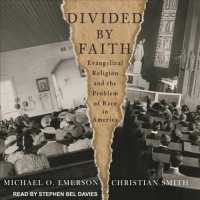- ホーム
- > 洋書
- > 英文書
- > History / World
Full Description
As runaway slaves fled from the South to escape bondage, slave catchers followed in their wake. The arrival of fugitives and slave catchers in the North set off violent confrontations that left participants and local residents enraged and embittered. Historian Robert H. Churchill places the Underground Railroad in the context of a geography of violence, a shifting landscape in which clashing norms of violence shaped the activities of slave catchers and the fugitives and abolitionists who defied them. Churchill maps four distinct cultures of violence: one that prevailed in the South and three more in separate regions of the North: the Borderland, the Contested Region, and the Free Soil Region. Slave catchers who followed fugitives into the North brought with them a Southern culture of violence that sanctioned white brutality as a means of enforcing racial hierarchy and upholding masculine honor, but their arrival triggered vastly different violent reactions in the three regions of the North. Underground activists adapted their operations to these distinct cultures of violence, and the cultural collisions between slave catchers and local communities transformed Northern attitudes, contributing to the collapse of the Fugitive Slave Act and the coming of the Civil War.
Contents
Part I. Origins to 1838: 1. Refugees all: the origins of the Underground Railroad; Part II. 1838-1850: 2. Under siege: borderland activists confront the violence of mastery; 3. Bondage and dignity: accommodation and collision in the contested region; 4. Free soil: Prigg, Latimer, and open resistance in the upper north; Part III. 1850-1860: 5. Law and degradation: lethal violence and beleaguered resistance in the borderland; 6. Above ground: open defiance and the limits of free soil; 7. The end of toleration: the collapse of the Fugitive Slave Act in the contested region; Epilogue: cultures of violence, secession, and war; Appendix: fugitive slave rescues, 1794-1861.





